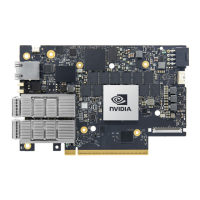Feature Description
GPU Direct GPUDirect RDMA is a technology that provides a direct P2P (Peer-
to-Peer) data path between the GPU Memory directly to/from the
NVIDIA HCA devices. This provides a significant decrease in GPU-
GPU communication latency and completely offloads the CPU,
removing it from all GPU-GPU communications across the
network. The DPU Controller uses high-speed DMA transfers to
copy data between P2P devices resulting in more efficient system
applications
Cryptography Accelerations From IPsec and TLS data-in-motion inline encryption to AES-XTS
block-level data-at-rest encryption and public key acceleration,
the DPU Controller hardware-based accelerations offload the
crypto operations and free up the CPU, reducing latency and
enabling scalable crypto solutions. BlueField-3 “host-unaware”
solutions may transmit and receive data, while BlueField-3 acts as
a bump-in-the-wire for crypto.
Security Accelerators A consolidated compute and network solution based on the DPU
Controller achieves significant advantages over a centralized
security server solution. Standard encryption protocols and
security applications can leverage NVIDIA BlueField-3 compute
capabilities and network offloads for security application
solutions such as Layer4 Statefull Firewall.
Out-of-Band Management The DPU Controller incorporates a 1GbE RJ45 out-of-band port
that allows the network operator to establish trust boundaries in
accessing the management function to apply it to network
resources. It can also be used to ensure management connectivity
(including the ability to determine the status of any network
component) independent of the status of other in-band network
components.
BMC The DPU Controller incorporate local NIC BMC (Baseboard
Management Controller) hardware on the board. The BMC SoC
(system on a chip) can utilize either shared or dedicated NICs for
remote access. The BMC node enables remote power cycling,
board environment monitoring, BlueField-3 chip temperature
monitoring, board power and consumption monitoring, and
individual interface resets. The BMC also supports the ability to
push a bootstream to BlueField-3.
Having a trusted on-board BMC that is fully isolated for the host
server ensures highest security for the DPU boards.

